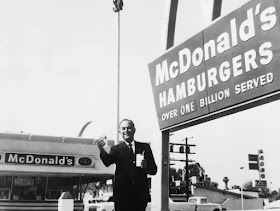The first recorded use of the term “Black Friday” was applied not to post-Thanksgiving holiday shopping but to financial crisis: specifically, the crash of the U.S. gold market on September 24, 1869. Two notoriously ruthless Wall Street financiers, Jay Gould and Jim Fisk, worked together to buy up as much as they could of the nation’s gold, hoping to drive the price sky-high and sell it for astonishing profits. On that Friday in September, the conspiracy finally unraveled, sending the stock market into free-fall and bankrupting everyone from Wall Street barons to farmers.
The most commonly repeated story behind the Thanksgiving shopping-related Black Friday tradition links it to retailers. As the story goes, after an entire year of operating at a loss (“in the red”) stores would supposedly earn a profit (“went into the black”) on the day after Thanksgiving, because holiday shoppers blew so much money on discounted merchandise. Though it’s true that retail companies used to record losses in red and profits in black when doing their accounting, this version of Black Friday’s origin is the officially sanctioned—but inaccurate—story behind the tradition.
The real history behind Black Friday, however, is not as sunny as retailers might have you believe. Back in the 1950s, police in the city of Philadelphia used the term to describe the chaos that ensued on the day after Thanksgiving, when hordes of suburban shoppers and tourists flooded into the city in advance of the big Army-Navy football game held on that Saturday every year. Not only were Philly cops not able to take the day off, but they had to work extra-long shifts dealing with the additional crowds and traffic. Shoplifters also took advantage of the bedlam in stores and made off with merchandise, adding to the law enforcement headache.By 1961, “Black Friday” had caught on in Philadelphia, to the extent that the city’s merchants and boosters tried unsuccessfully to change it to “Big Friday” in order to remove the negative connotations. The term didn’t spread to the rest of the country until much later, however, and as recently as 1985 it wasn’t in common use nationwide. Sometime in the late 1980s, however, retailers found a way to reinvent Black Friday and turn it into something that reflected positively, rather than negatively, on them and their customers. The result was the “red to black” concept of the holiday mentioned earlier, and the notion that the day after Thanksgiving marked the occasion when America’s stores finally turned a profit.
The Black Friday story stuck, and pretty soon the term’s darker roots in Philadelphia were largely forgotten. Since then, the one-day sales bonanza has morphed into a four-day event, and spawned other “retail holidays” such as Small Business Saturday/Sunday and Cyber Monday. Stores started opening earlier and earlier on that Friday, and now the most dedicated shoppers can head out right after their Thanksgiving meal.OK, the above AI generated History Lesson of Black Friday is now over. Did you buy anything on Black Friday? Did you watch the Amazon Prime NFL Black Friday game, full of QR codes? How many Black Friday Deals have now been EXTENDED, making the sense of urgency to spend $$$ on THAT DAY and at THAT TIME moot?
What is the opposite of Black Friday?
In North America, the United Kingdom, Finland and Sweden, Buy Nothing Day is held the day after U.S. Thanksgiving, concurrent with Black Friday; elsewhere, it is held the following day, which is the last Saturday in November. How about the Buy Nothing Coat Exchange: Four states, including Utah, hold winter coat exchange programs as an alternative to Black Friday shopping.
I write this Sunday Blog sandwiched between Black Friday and Cyber Monday.
Cyber Monday is a marketing term for e-commerce transactions on the Monday after Thanksgiving in the United States. It was created by retailers to encourage people to shop online. The term was coined by Ellen Davis of the National Retail Federation and Scott Silverman, and made its debut on November 28, 2005, in a Shop.org press release entitled "'Cyber Monday' Quickly Becoming One of the Biggest Online Shopping Days of the Year". Cyber Monday takes place the Monday after Thanksgiving; the date falls between November 26 and December 2, depending on the year.Cyber Monday has become the online equivalent to Black Friday and offers a way for smaller retail websites to compete with larger chains. Since its inception, it has become an international marketing term used by online retailers around the world.
It was not too many years ago, that my two sons would go to Best Buy on Black Friday at the crack of dawn (with my credit card) and I would say "Bring back something good!" And then, it became "We're off to Best Buy..." ON THANKSGIVING DAY, right after the Pumpkin Pie was served.
Well, whatever "Holiday" you celebrate (Black Friday, Cyber Monday, EXTENDED BLACK FRIDAY...) my only tip to you is this: never buy the extended warranty. That's for chumps.
.jpeg)

















